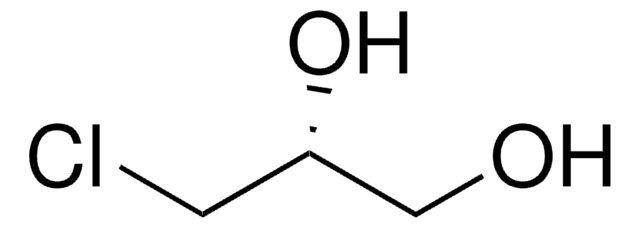Y0001048
(±)-Glicidol
European Pharmacopoeia (EP) Reference Standard
Sinónimos:
(±)-Oxiran-2-metanol, 2,3- epoxi-1-propanol, Glicerolglúcido
Seleccione un Tamaño
About This Item
Productos recomendados
grado
pharmaceutical primary standard
densidad de vapor
2.15 (vs air)
presión de vapor
0.9 mmHg ( 25 °C)
familia API
levodropropizine
temp. de autoignición
780 °F
fabricante / nombre comercial
EDQM
índice de refracción
n20/D 1.433 (lit.)
bp
61-62 °C/15 mmHg (lit.)
densidad
1.117 g/mL at 25 °C (lit.)
aplicaciones
pharmaceutical (small molecule)
Formato
neat
temp. de almacenamiento
−20°C
cadena SMILES
OCC1CO1
InChI
1S/C3H6O2/c4-1-3-2-5-3/h3-4H,1-2H2
Clave InChI
CTKINSOISVBQLD-UHFFFAOYSA-N
¿Está buscando productos similares? Visita Guía de comparación de productos
Categorías relacionadas
Descripción general
Aplicación
Envase
Otras notas
Producto relacionado
Palabra de señalización
Danger
Frases de peligro
Clasificaciones de peligro
Acute Tox. 2 Inhalation - Acute Tox. 4 Dermal - Acute Tox. 4 Oral - Carc. 1B - Eye Irrit. 2 - Muta. 2 - Repr. 1B - Skin Irrit. 2 - STOT SE 3
Órganos de actuación
Respiratory system
Código de clase de almacenamiento
6.1A - Combustible acute toxic Cat. 1 and 2 / very toxic hazardous materials
Clase de riesgo para el agua (WGK)
WGK 3
Punto de inflamabilidad (°F)
161.6 °F
Punto de inflamabilidad (°C)
72 °C
Elija entre una de las versiones más recientes:
Certificados de análisis (COA)
It looks like we've run into a problem, but you can still download Certificates of Analysis from our Documentos section.
Si necesita más asistencia, póngase en contacto con Atención al cliente
¿Ya tiene este producto?
Encuentre la documentación para los productos que ha comprado recientemente en la Biblioteca de documentos.
Active Filters
Nuestro equipo de científicos tiene experiencia en todas las áreas de investigación: Ciencias de la vida, Ciencia de los materiales, Síntesis química, Cromatografía, Analítica y muchas otras.
Póngase en contacto con el Servicio técnico








